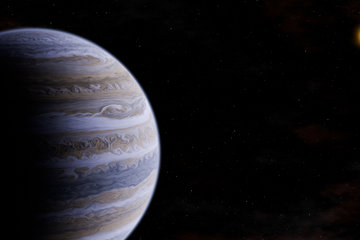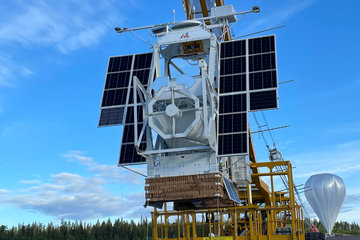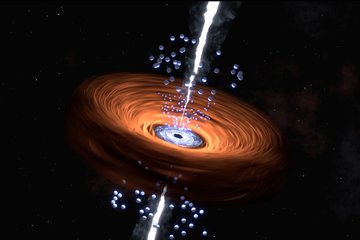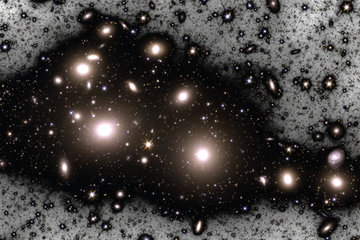An X-ray image of half the universe
First eROSITA sky-survey data release makes public the largest ever catalogue of high-energy cosmic sources
X-ray astronomy has an eventful 60-year history of exploring the extremes of the universe: from exploding stars to active galactic nuclei, which, with their supermassive black holes, are arguably the most efficient sources of energy in the universe. While most X-ray telescopes were built to take a closer look at such phenomena, eRosita looks at the bigger picture. These include the largest structures in the universe, filaments of hot gas that connect powerful clusters of galaxies and could hold the answers to the biggest questions: how did the universe evolve and why is it expanding?

The German eRosita consortium has today published its share of the data collected by the eRosita X-ray telescope on board the Spektrum-RG satellite during the first all-sky survey. The first eRosita All-Sky Survey Catalogue (eRASS1) is the largest collection of X-ray sources ever published, with around 900,000 individual sources. Along with the data, the consortium is publishing a series of scientific papers on new findings ranging from planetary habitability studies to the discovery of the largest cosmic structures. In the first six months of observation, eRosita has already discovered more X-ray sources than have been known in the 60-year history of X-ray astronomy. The data is available to the global scientific community.
More than 700.000 supermassive black holes
Panning through the eROSITA sky
The eRASS1 observations with the eROSITA telescope were carried out from 12 December 2019 to 11 June 2020. The data published here cover half of the entire sky, the data share of the German eROSITA consortium. In the most sensitive energy range of the eROSITA detectors (0.2-2 keV), the telescope detected 170 million X-ray photons - a record number. In X-ray astronomy, it is possible to measure individual particles of light (photons) with their respective energy in the X-ray spectrum and their arrival time in the detector. The catalogue was then constructed – after careful processing and calibration – by detecting concentrations of photons in the sky against a bright, large-scale, diffuse background. After eRASS1, eROSITA has continued scanning the sky and accumulated several additional all-sky surveys. Those data will also be released to the world in the coming years.
The 900,000 sources include around 710 000 supermassive black holes in distant galaxies (active galactic nuclei), 180.000 X-ray emitting stars in our own Milky Way, 12.000 clusters of galaxies, plus a small number of other exotic classes of sources like X-ray emitting binary stars, supernova remnants, pulsars, and other objects. “These are mind-blowing numbers for X-ray astronomy,” says Andrea Merloni, eROSITA principal investigator and first author of the eROSITA catalogue paper. “We’ve detected more sources in 6 months than the big flagship missions XMM-Newton and Chandra have done in nearly 25 years of operation.”
Can X-rays from stars make planets uninhabitable?
Co-ordinated with the release, the German eROSITA Consortium has submitted almost 50 new scientific publications to peer-reviewed journals, adding to the more than 200 which had already been published by the team before the data release. Most of the new papers appear today with selected discoveries including: more than 1000 superclusters of galaxies, the giant filament of pristine warm-hot gas extending between two galaxy clusters and two new ‘Quasi-Periodically Erupting’ black holes. Further studies of how X-ray irradiation from a star may affect the atmosphere and water retention of orbiting planets, and statistical analysis of flickering supermassive black holes .
“The scientific breadth and impact of the survey is quite overwhelming; it’s hard to put into a few words,” says Mara Salvato, who as spokesperson for the German eROSITA consortium co-ordinates the efforts of about 250 scientists organised into 12 working groups. “But the papers published by the team will speak for themselves.”
This first eRASS data release (DR1) makes public not only the source catalogue, but images of the X-ray sky at multiple X-ray energies and even lists of the individual photons with their sky positions, energies and precise arrival times. The software needed to analyse the eROSITA data is also included in the release. For many source classes, supplementary data from other wavebands has also been incorporated into so-called “value-added” catalogues that go beyond pure X-ray information. “We’ve made a huge effort to release high-quality data and software,” added Miriam Ramos-Ceja, who leads the eROSITA Operations team. “We hope this will broaden the base of scientists worldwide working with high-energy data and help push the frontiers of X-ray astronomy.”
“The eROSITA collaboration has done an outstanding job with the data release and at the same time publishing all of these amazing new results,” says Kirpal Nandra, Director at MPE. “There’s a lot more to come from us, and we’re looking forward to seeing what the rest of the world will do with the public data.”
Keen eROSITA-watchers may know that the driving scientific objective that motivated the telescope was to constrain cosmological models using clusters of galaxies. The cosmology results, based on an in-depth analysis of the eRASS1 clusters, will be released in approximately two weeks. Watch this space!
HH, BEU
Additional Information
eROSITA is the soft X-ray instrument aboard Spektrum-RG (SRG), a joint Russian-German science mission supported by the Russian Space Agency (Roskosmos), in the interests of the Russian Academy of Sciences represented by its Space Research Institute (IKI), and the German Space Agency at DLR (Deutsches Zentrum für Luft- und Raumfahrt). The SRG spacecraft was built by Lavochkin Association (NPOL) and its subcontractors, and is operated by NPOL with support from the Max-Planck Institute for Extraterrestrial Physics (MPE).
The telescope was launched into space onboard the SRG mission on July 13, 2019. Its large collecting area and wide field of view are designed to perform to a deep all-sky survey in the X-ray band. Over the course of six months (December 2019 to June 2020), SRG/eROSITA completed the first survey of the whole sky at energies 0.2-8 keV, which is significantly deeper than the only existing all-sky survey with an X-ray imaging telescope, performed by ROSAT in 1990 at energies 0.1-2.4 keV. Three more scans of the entire sky were completed between June 2020 and February 2022.
The German eROSITA Consortium is led by the Max Planck Institute for Extraterrestrial Physics (MPE), and includes the Dr. Karl Remeis Observatory Bamberg, the University of Hamburg Observatory, the Leibniz Institute for Astrophysics Potsdam (AIP), and the Institute for Astronomy and Astrophysics of the University of Tübingen, with the support of DLR and the Max Planck Society. The Argelander Institute for Astronomy of the University of Bonn and the Ludwig-Maximilians-Universität Munich also participate in the science exploitation of eROSITA as associated institutes.The eROSITA data are processed using the eSASS software system developed by the German eROSITA consortium.
eROSITA has been placed in Safe Mode in February 2022, and has not restarted science operations since.












